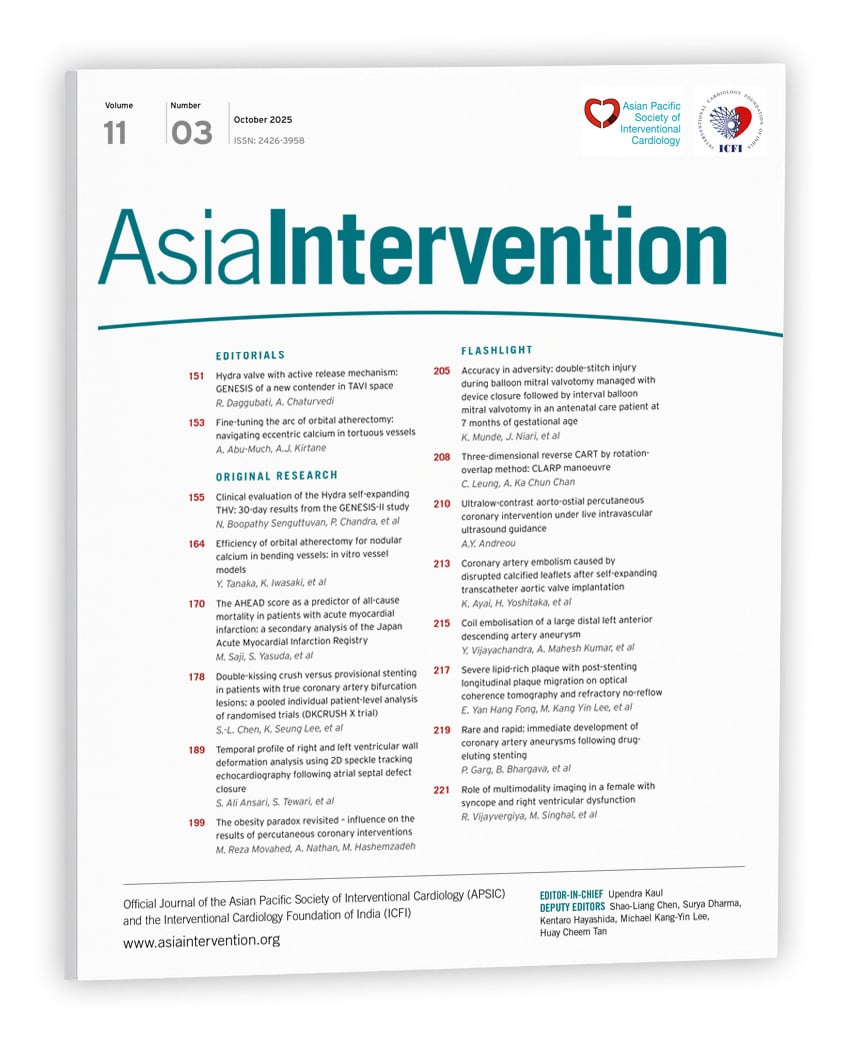The patient, a 64-year-old male with a history of smoking, presented with worsening angina over the previous four months. He had a history of anterior wall ST-segment elevation myocardial infarction five months prior, for which he underwent primary percutaneous coronary intervention (PCI) to the left anterior descending artery (LAD). Two drug-eluting stents (DES) were implanted: an everolimus-eluting XIENCE Prime (3.0×28 mm; Abbott) in the proximal to mid-LAD and a biodegradable-polymer sirolimus-eluting Supralimus Grace (2.75×48 mm; Sahajanand Medical Technologies) in the mid- to distal LAD (Figure 1A, Figure 1B, Moving image 1). One week later, the patient suffered from an episode of unstable angina. Coronary angiography revealed multiple aneurysms in the LAD starting from the proximal edge of the distal stent (Figure 1C, Figure 1D, Moving image 2). The patient opted for medical management; however, his angina did not improve. The patient had mild left ventricular dysfunction with LAD territory hypokinesia. An electrocardiogram showed normal sinus rhythm with poor R wave progression without Q waves. His blood workup and cardiac 18F-fluorodeoxyglucose positron emission tomography were not suggestive of infection (total leucocyte count 8,400 cells/mm3, erythrocyte sedimentation rate 10 mm/hr, C-reactive protein 3 mg/dL, procalcitonin <0.05 ng/mL, blood cultures negative). Repeat coronary angiography showed multiple saccular aneurysms in the mid- to distal LAD (largest diameter 7 mm) with contrast stasis and distal slow flow. Mild diffuse in-stent restenosis was also present in the proximal stent (Figure 1E, Moving image 3). After shared decision-making with the Heart Team, a percutaneous approach was planned for the patient. Pre-PCI optical coherence tomography revealed the stent edges hanging freely at the sites of saccular aneurysms, with mild neointimal hyperplasia in the parts without aneurysms (Figure 1G–Figure 1H–Figure 1I–Figure 1J–Figure 1K, Moving image 4). The aneurysms were successfully managed with two overlapping covered stents, GRAFTMASTER RX (Coronary Stent Graft System [Abbott]), sized 2.8×26 mm and 2.8×19 mm. Post-PCI, there was complete disappearance of the aneurysms and Thrombolysis in Myocardial Infarction 3 flow in the LAD was achieved (Figure 1F, Moving image 5). The patient had significant symptom improvement at 1-year follow-up. Coronary artery aneurysms occurring after percutaneous interventions with DES are rare, with a reported incidence of 0.2-2.3%1. Acute aneurysms, occurring within four weeks of procedure are usually due to injury to the vessel wall from high-pressure balloons, oversized stents, or deep resections using laser atherectomy2. Natural endothelisation and healing are inhibited by the action of antiproliferative agents in DES, while shear stress from blood flow causes further progression. Subacute aneurysms may represent a hypersensitivity response to the DES, while infective aneurysms can present at any time345. In our patient, the acute onset of large aneurysms, in the absence of infection, suggests that mechanical injury during the index procedure was the most likely cause of aneurysm formation. Treatment options include medical therapy (antiplatelets or anticoagulants), percutaneous therapy (either covered stents or coil embolisation), and surgical treatment. Infected aneurysms should be resected. Other patients may be offered the options of surgery or percutaneous intervention based on the amenability of the lesion to intervention. Patients who are asymptomatic with small aneurysms that do not progress may be kept on close follow-up with coronary computed tomography angiography. This report highlights acute coronary artery aneurysm development as an uncommon but urgent cause of post-PCI angina, which may occur as early as one week, emphasising that intracoronary imaging is vital in determining the mechanism of injury and guiding management. 
Figure 1. Coronary artery aneurysms after DES PCI. A) Index presentation of anterior wall STEMI, with the infarct-related artery identified as the left anterior descending artery (LAD). The initial angiogram revealed a patent vessel, likely due to spontaneous recanalisation, along with significant mid-LAD disease. The distal vessel is noted to be of thin calibre. B) Percutaneous coronary intervention (PCI) was performed using drug-eluting stents (DES) in the LAD, resulting in TIMI 3 flow. A slight step-down is observed just distal to the distal stent, likely indicative of stent edge dissection or stent oversizing. C) One week post-PCI, the patient presented with unstable angina. Repeat angiography demonstrated the presence of multiple saccular aneurysms in the LAD, originating just distal to the proximal stent. (D,E) Progression in both the size and number of the aneurysms over time. F) Following the deployment of covered stents, TIMI 3 flow was achieved in the LAD with no residual aneurysms observed. (G,H) Optical coherence tomography (OCT) prior to deployment of the covered stent revealed multiple aneurysms beginning at the proximal edge of the distal stent, with no evidence of thrombus or mass present within the aneurysms. I) Proximal fibrous in-stent restenosis on OCT. (J,K) Further OCT imaging confirmed multiple aneurysms starting from the proximal edge of the distal stent, again with no evidence of thrombus or mass noted within the aneurysms. TIMI: Thrombolysis in Myocardial Infarction
Conflict of interest statement
The authors have no conflicts of interest to declare in relation to this manuscript.

